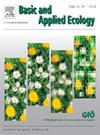Towards an effective in-situ biodiversity assessment in European forests
IF 3.5
2区 环境科学与生态学
Q2 ECOLOGY
引用次数: 0
Abstract
Assessing multi-taxon biodiversity is crucial to understand forests’ response to environmental changes and to inform management strategies. In Europe, forest biodiversity monitoring is still scattered and heterogeneous, although a long-term monitoring network has long been advocated. Given the monitoring aims reported in various EU policies, this network should be accurately designed also through the estimation of its sampling effort, here intended as the number of sampling plots and sites.
We used a novel database of forest multi-taxon biodiversity for a pilot study to: estimate the minimum sampling effort needed to: assess variation in species richness and composition; compare these estimates with the efforts invested in the pilot database; discuss estimates’ differences across taxonomic groups and forest categories.
We focused on six taxonomic groups (vascular plants, birds, epiphytic lichens and bryophytes, wood-inhabiting fungi and saproxylic beetles) across six forest categories. Based on 6,165 plots at 2,084 different locations across Europe, we benchmarked the effort to achieve: a complete species richness estimate through interpolation/extrapolation curves, and a precise evaluation of species composition variation through multivariate standard error.
Our estimates differed widely, especially among taxonomic groups. For species richness, estimates range from 3 to 147 plots per site across 3 to 29 sites per forest category, with birds and epiphytic bryophytes requiring the least effort. For species composition, estimates range from 5 to over 25 plots per site across 5 to 20 sites per forest category, with saproxylic beetles, vascular plants, and fungi displaying the highest estimates.
The taxonomic groups requiring an effort comparable to existing data were the least diverse, all the others need greater efforts, either for species richness (e.g., saproxylic beetles), or species composition (e.g., vascular plants), or both (e.g., wood-inhabiting fungi). An effective monitoring network of European forests’ biodiversity should thoroughly account for these benchmarks and for their taxon-dependency.
对欧洲森林进行有效的原位生物多样性评估
评估多分类生物多样性对于了解森林对环境变化的反应和为管理战略提供信息至关重要。在欧洲,森林生物多样性监测仍然是分散和异质性的,尽管长期监测网络一直被提倡。鉴于欧盟各项政策中报告的监测目标,也应通过估计其抽样努力来准确设计该网络,这里指的是抽样地块和地点的数量。我们使用了一个新的森林多分类生物多样性数据库进行初步研究,以估计评估物种丰富度和组成变化所需的最小采样努力;将这些估计数与投入试点数据库的努力进行比较;讨论不同分类类群和森林类别的估计值差异。我们集中研究了6个森林分类类群(维管植物、鸟类、附生地衣和苔藓植物、木栖真菌和腐木甲虫)。基于欧洲2084个不同地点的6165个样地,通过插值/外推曲线估算完整的物种丰富度,通过多变量标准误差精确评估物种组成变化。我们的估计差异很大,特别是在不同的分类组之间。在物种丰富度方面,每个森林类别的3 - 29个样地中每个样地的估计值在3 - 147个样地之间,鸟类和附生苔藓类所需的努力最少。在物种组成方面,在每个森林类别的5 - 20个样地中,每个样地的估计值在5 - 25个样地之间,腐木甲虫、维管植物和真菌的估计值最高。需要与现有数据相当的努力的分类类群是多样性最少的,所有其他类群都需要更大的努力,要么是物种丰富度(例如腐木甲虫),要么是物种组成(例如维管植物),或者两者兼而有之(例如木栖真菌)。一个有效的欧洲森林生物多样性监测网络应该彻底考虑到这些基准和它们的分类依赖。
本文章由计算机程序翻译,如有差异,请以英文原文为准。
求助全文
约1分钟内获得全文
求助全文
来源期刊

Basic and Applied Ecology
环境科学-生态学
CiteScore
6.90
自引率
5.30%
发文量
103
审稿时长
10.6 weeks
期刊介绍:
Basic and Applied Ecology provides a forum in which significant advances and ideas can be rapidly communicated to a wide audience. Basic and Applied Ecology publishes original contributions, perspectives and reviews from all areas of basic and applied ecology. Ecologists from all countries are invited to publish ecological research of international interest in its pages. There is no bias with regard to taxon or geographical area.
 求助内容:
求助内容: 应助结果提醒方式:
应助结果提醒方式:


